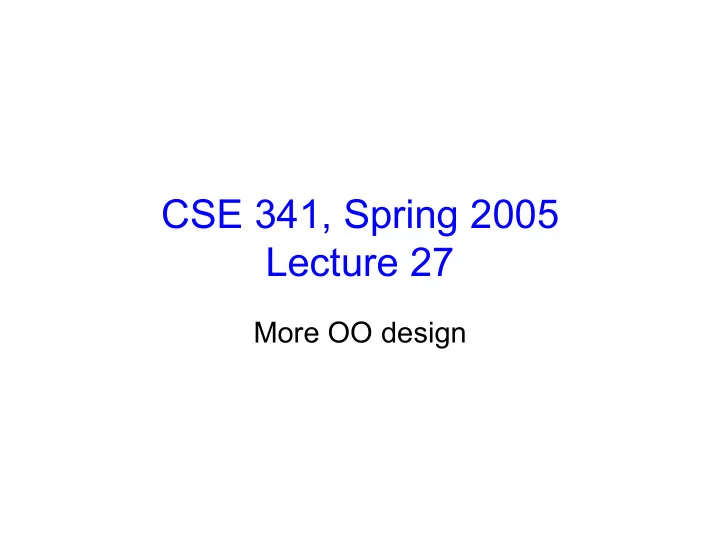

CSE 341, Spring 2005 Lecture 27 More OO design
“Classic” C struct Widget {width, height, type , … type-specific fields… } Widget[1000] data; x = 0; y = 0; for(i = 0; i < n; i++) { if(x+data[i].width > linewidth) {x = 0; y += maxh; maxh = 0} switch ( data[i].type ) { 1: drawstring(x,y,data[i].string,…); break; 2: drawradio(x,y,data[i].radiolabels,…); break; 3: … } x += data[i].width; maxh = max(maxh,data[i].height) }
Better C struct Widget {width, height, type, … type-specific fields… } Widget[1000] data; x = 0; y = 0; for(i = 0; i < n; i++) { if(x+data[i].width > linewidth) {x = 0; y += maxh; maxh = 0} draw_widget(x,y,data[i]); x += data[i].width; maxh = max(maxh,data[i].height) } void draw_widget(x,y,theWidget) { switch ( theWidget.type ) { 1: drawstring(x,y,theWidget.string,…); break; 2: drawradio(x,y,theWidget.radiolabels,…); break; 3: … } }
Java abstract class Widget { Widget[] data; // initialized somehow int: width, height x = 0; y = 0; maxh = 0; abstract void draw(x,y) for(i = 0; i < data.length; i++) { } if(x+data[i].width > linewidth) { class strWidget extends Widget { x = 0; String: string… y += maxh; void draw(x,y) { maxh = 0 drawstr(x,y,string,…) } }} data[i].draw(x,y) class radioWidget extends Widget { x += data[i].width; String: radiolabels… maxh = max(maxh,data[i].height) void draw(x,y) { drawradio(x,y,radiolabels,…) } }} …
Scheme • A widget is stored as a list, with type, width, height, … in fixed positions • A screen is a list of widgets • Main algorithm is pretty similar to above, except recursion (or mapcar) used to iterate over list • Code seems somewhat opaque since widget fields often accessed as “(cadddr widgetlist)”, e.g.
ML • A lot like Scheme, but use of ML data struct makes field access more transparent • Iteration via “foldl”, using another data struct to “accumulate” info about current x, y to decide whether next widget fits on a line
Critique
Pro/Con of OO design (here) • Algorithm recognizably the same in all four languages, despite, e.g., loops vs recursion vs fold. + OO Localizes/groups/encapsulates info + Main does layout alg, largely widget-independent + Widget holds generic widget-essence + Subclasses hold widget-specific stuff + OO probably better for code reuse/extension - OO somewhat verbose - Re Scheme: typlessness is a 2-edged sword, & lack of named data struct fields probably hurts (the “cadddr” problem)
Change Orders • Format control – Fonts, sizes, colors, … • Layout control – Justification, recursive subregions, tables… • New widgets – Sliders, dials, pull-downs, .png, .jpg, … • Windows/Mac/Linux ports…
Recommend
More recommend